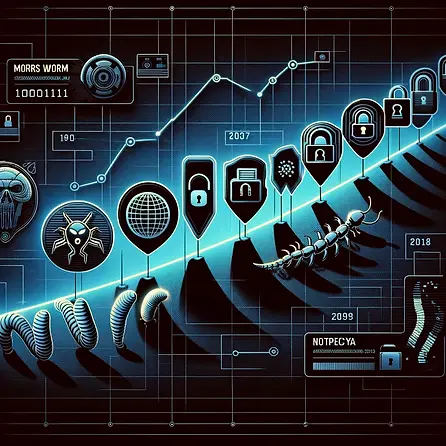
History of Cyberattacks
Significant cyberattacks and lessons learned

1988
Morris Worm
One of the first worms distributed via the internet that caused widespread outages and damage.
-
Cause: Created by Robert Tappan Morris, it was intended to gauge the size of the internet. However, due to a programming error, it replicated excessively, causing systems to overload.
-
Lessons Learned: Highlighted the need for network security and the potential of the internet for spreading malware. It led to the creation of the first Computer Emergency Response Team (CERT).
1998
Solar Sunrise
A series of attacks on U.S. military systems that were initially suspected to be from a foreign government but were later found to be the work of two teenagers from California and an Israeli teenager.
-
Cause: Exploited a known vulnerability in the Solaris operating system to gain unauthorized access to military computers.
-
Lessons Learned: Underlined the importance of patch management and the need for robust monitoring systems to detect unusual activities, leading to improved security protocols within the Department of Defense.


2000
ILOVEYOU Virus
A computer worm that spread via email and file sharing, causing billions in damages worldwide.
-
Cause: Spread via email with a subject line "ILOVEYOU" and an attachment that, when opened, would replicate itself and overwrite files.
-
Lessons Learned: Demonstrated the dangers of social engineering and the necessity for email security practices, including not opening suspicious attachments and the implementation of better antivirus software.
2003
SQL Slammer
A fast-spreading worm that caused a significant denial of service on some internet hosts and dramatically slowed down general internet traffic.
-
Cause: A buffer overflow vulnerability in Microsoft SQL Server 2000 that allowed the worm to rapidly replicate and spread.
-
Lessons Learned: Emphasized the critical importance of keeping software updated with patches and the need for systems to be protected behind firewalls with proper configurations.


2010
Stuxnet
A sophisticated computer worm designed to sabotage Iran's nuclear program. It's one of the first known worms to target industrial systems specifically.
-
Cause: Believed to be a state-sponsored attack, it targeted Siemens industrial control systems with the intention of damaging Iran's nuclear program. It exploited zero-day vulnerabilities and was introduced via infected USB drives.
-
Lessons Learned: Exposed the vulnerabilities in critical infrastructure and the potential for cyber weapons to cause physical damage, leading to increased focus on securing industrial control systems.
2014
Sony Pictures Hack
A breach where personal information about Sony Pictures employees and their families, emails between employees, information about executive salaries, and copies of then-unreleased Sony films were released.
-
Cause: A group called "Guardians of Peace" infiltrated Sony's network, allegedly motivated by the planned release of "The Interview," a film that depicted North Korea unfavorably.
-
Lessons Learned: Highlighted the need for better corporate cybersecurity practices, the risks of insider threats, and the importance of securing sensitive data.


2017
WannaCry Ransomware Attack
A global ransomware attack that targeted computers running the Microsoft Windows operating system by encrypting data and demanding ransom payments in Bitcoin.
-
Cause: Exploited a vulnerability in Windows SMB protocol, known as EternalBlue, which was leaked by the Shadow Brokers group.
-
Lessons Learned: Underlined the critical need for regular software updates, the dangers of using unsupported software, and the importance of backups in mitigating ransomware attacks.
2017
NotPetya
Initially thought to be ransomware, this attack primarily targeted Ukrainian organizations but had a global impact. It's considered one of the most destructive cyberattacks in history.
-
Cause: Initially spread through a Ukrainian tax software update, it used the same EternalBlue exploit as WannaCry and was designed to spread rapidly within corporate networks.
-
Lessons Learned: Reinforced the importance of secure software supply chains, the need for robust incident response plans, and the consideration of geopolitical risks in cybersecurity strategies.


2017
Equifax Data Breach
A breach that exposed the personal information of approximately 147 million people, including Social Security numbers, birth dates, addresses, and in some instances, driver's license numbers.
-
Cause: Exploited a vulnerability in the Apache Struts framework used by Equifax's website. The breach was exacerbated by a failure to patch the known vulnerability in a timely manner.
-
Lessons Learned: Stressed the importance of vulnerability management, the need for strong internal controls and audits, and the potential consequences of data breaches on privacy and identity theft.
2020
SolarWinds Hack
A sophisticated and widespread supply chain attack that compromised the SolarWinds Orion software, affecting numerous government agencies and major corporations.
-
Cause: A sophisticated supply chain attack that compromised the Orion software update mechanism, allowing attackers to gain access to the networks of SolarWinds' customers.
-
Lessons Learned: Highlighted the risks associated with supply chain attacks, the need for secure software development practices, and the importance of monitoring and securing network traffic to detect anomalies.
